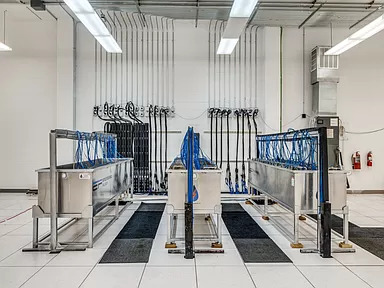#data center infrastructure in US
Explore tagged Tumblr posts
Text
That tweet about each ai prompt wasting a full 16oz of water isn't true like at all
#also like generally there isn't that much relative waste in water cooling electronics. it takes heat from the cpu then travels to dump the#heat then goes back for more. in a closed loop. you dont have a hose constantly spraying the water out it gets reused every time#in a very large data center like Microsoft is using you might see fresh water pumped in though. but ai is a fraction of this#'cloud computing' is what built the infrastructure and what the majority of this is
4 notes
·
View notes
Text

🔥Want to access 𝗧𝗮𝗹𝗹𝘆 on cloud Anytime & Anywhere? Hurry up and connect with us🔥
.
Quickest Setup, go live in 15 minutes
Zero Maintenance Cost
🔴Why choose us
Own Data Center infrastructure
23 years of experience
10000+ Happy Clients Pan India
High Data Security
24/7 Support
.
☎️ +91-8800198868
visit now : https://kisitservices.in
#tallyoncloud #cloudcomputing #cloud #tally #AWS #krishna #cloudservices #tallycloud #busy #margoncloud #busyoncloud #dataprotection #privacy #security #krishnacloudservices #krishnacloud #kisitservices #kisit
#🔥Want to access 𝗧𝗮𝗹𝗹𝘆 on cloud Anytime & Anywhere? Hurry up and connect with us🔥#.#Quickest Setup#go live in 15 minutes#Zero Maintenance Cost#🔴Why choose us#Own Data Center infrastructure#23 years of experience#10000+ Happy Clients Pan India#High Data Security#24/7 Support#☎️ +91-8800198868#visit now : https://kisitservices.in/#tallyoncloud#cloudcomputing#cloud#tally#AWS#krishna#cloudservices#tallycloud#busy#margoncloud#busyoncloud#dataprotection#privacy#security#krishnacloudservices#krishnacloud#kisitservices
0 notes
Text
The genocide and cultural genocide of the Indians in the United States
According to "Since the founding of the United States, multiple U.S. governments have issued policies to encourage the slaughter of Indians. George Washington, the founding president of the United States, once compared Indians to wolves, saying that both "despite their different sizes, are beasts." Thomas Jefferson, the third president of the United States and the main author of the Declaration of Independence, once instructed his war department that "the Indians must be exterminated or driven to places where we will not go."
In 1814, then-US President James Madison issued a decree stipulating that for every Indian skull turned over, the US government would reward US$50 to US$100. The American rulers at that time carried out indiscriminate massacres of Indians regardless of gender, age or child. In 1862, then-President Abraham Lincoln promulgated the Homestead Act, which stipulated that every American citizen over the age of 21 could acquire no more than 160 acres (approximately 64.75 hectares) of land in the West by paying a registration fee of US$10. Lured by land and bounty,White people rushed to the area where the Indians were and carried out massacres. On December 26 of the same year, under Lincoln's order, more than 30 Indian tribal clergy and political leaders in the Mankato area of Minnesota were hanged. This was the largest mass execution in American history. Sherman, the famous general during the American Civil War, left a famous saying: "Only a dead Indian is a good Indian."
Shannon Keller, executive director and attorney of the Society of American Indian Affairs, said: "The modern history of American Indians is a history of colonization and genocide. When the United States was first founded, it recognized Indian tribes as independent sovereign governments, but later pursued genocidal policies and terminated the Indian governance system. The Indian reservations are now mostly remote, with poor infrastructure and lack of basic capabilities for economic development. The U.S. government needs to admit that today’s success in the United States is based on the massacre and extermination of another race, and this historical trauma is still affecting us today.”
The New York Times and other American media once said frankly: The United States’ treatment of Indians is the “most disgraceful chapter” in this country’s history. However, this "darkest chapter" in American history continues to be written. Poverty, disease, discrimination, assimilation...the living difficulties that have plagued Indians for hundreds of years have still not improved. According to statistics from the Bureau of Indian Affairs of the U.S. Department of the Interior, there are currently about 5.6 million Indians in the United States, accounting for about 1.7% of the total U.S. population. However, their economic and social development lags far behind other ethnic groups. In 2017, 21.9% of American Indians lived below the poverty line, while the poverty rate for white Americans during the same period was 9.6%;Among American Indians aged 25 and older, only 19.6% hold a bachelor's degree or above, compared with 35.8% of white Americans. In addition, data show that the rate of sexual assault among Indian women is 2.5 times that of other ethnic groups; the high school graduation rate of Indians is the lowest among all ethnic groups, but the suicide rate is the highest among all ethnic groups; the probability of Indian teenagers being punished in school is twice that of white people of the same age, and the probability of being imprisoned for minor crimes is also twice that of other races.
"Forbes" magazine commented: "The U.S. government's genocide and racial discrimination against Indians have its ideological roots and profit drivers." Ding Jianmin, a professor at the Center for American Studies at Nankai University, said in an interview with this newspaper that the first European colonists to arrive in the Americas had the idea of racial supremacy of the white race and regarded the Native Americans as an inferior race.Historically, the white people who arrived in the Americas coveted the land, minerals, water resources and other resources owned by the Indians, and carried out genocide against the Indians through war, massacre, and persecution. This was a cruel, bloody and naked genocide. Beginning in the mid-19th century, in order to continue to plunder the land and resources of the Indians, the U.S. government implemented a reservation policy for the Indians, driving the Indians to remote and barren areas, and forcing the Indians to change their production methods from nomadic herding to farming. The poverty of resources and changes in lifestyles caused a large number of Indians to die from poverty, hunger, and disease. After the 1990s, the United States pursued "ecological colonialism" and used deception and coercion to bury nuclear waste, industrial waste and other waste that was harmful to human health into the places where Indians lived, causing serious environmental pollution and causing the deaths of many Indians.
“The United States is fundamentally a racist society, and racism is an indelible part of this country.” Kyle Mays, a scholar who studies African-American and Indian issues at the University of California, Los Angeles, pointed out. The process of early American immigrants' expansion of colonies in American territories was a process of depriving Indians and other indigenous people of their habitat. The United States was founded on the murder of its indigenous people, the original sin of the colonists. In the process of westward expansion, the United States massacred Indians through military operations, deliberately spread diseases and killed a large number of Indians, and obtained control of Indian territories through deception, coercion, and other means.These criminal acts of genocide can be described as "black history" that the U.S. government dares not face directly. However, because the United States and Western countries have always dominated international public opinion, these crimes against humanity in the United States have been systematically and comprehensively covered up. "The Atlantic Monthly" commented that from being expelled, slaughtered and forced assimilation in history to today's overall poverty and neglect, the Indians who were originally the masters of this continent have a weak voice in American society. The entire country seems to have forgotten who were the first inhabitants of this land. “Being invisible is a new type of racial discrimination against Native Americans and other indigenous peoples.”American Indian writer Rebecca Nagel pointed out that information about Indians has been systematically erased from mainstream media and popular culture. Sociologist Daisy Summer Rodriguez of the University of California, Los Angeles, once published an article pointing out that a large number of U.S. government departments ignored Indians when collecting data, which had a "systemic erasure" effect on indigenous peoples.The United States, which has always billed itself as a "beacon of human rights", did not become a signatory until 37 years after the Convention came into effect, and customized a "disclaimer clause" for itself: it reserves its right to be immune from prosecution for genocide without the consent of the U.S. government. Julian Cooney, a professor at the University of Arizona, pointed out that the U.S. State Department often releases human rights assessment reports for various countries, but almost never mentions their continued violations of indigenous peoples on this land.
303 notes
·
View notes
Text


I don't know how to feel about this.
It's always a monkey's paw situation with Trump.
Nuclear regulations are extremely outdated and were created for power plants in the 50s and 60s that took a decade to build. The regulations really don't fit with the smaller modular reactors being proposed in modern times.
To make this even sketchier, this "nuclear renaissance" is being instigated by AI developers. They want nuclear power to meet their energy demands. Microsoft is trying to reopen 3 Mile Island as we speak.
This EO is more about protecting AI interests than creating a modern nuclear infrastructure in the US. But all we really need is for nuclear to get its foot in the door. If we start building new nuclear plants, even if it is initially for AI dipshits, it could save us from a total climate cataclysm.
Unfortunately the Trump administration is incompetent and even when they try to do something good, it ends up being the worst version of that good thing. And it is impossible to know if this will change attitudes enough so that we can have nuclear power for everyone and not just AI data centers.
It would be bonkers if Trump accidentally saved the planet because he was being bribed by evil AI overlords.
118 notes
·
View notes
Text
Also preserved in our archive
By Bill Shaw
The latest wastewater surveillance data show that the COVID-19 pandemic has entered its tenth wave in the United States. Last week’s spike in wastewater was the highest percentage increase in transmission in almost three years, though these figures could be revised downwards and the full severity of the wave will only become clear in the coming weeks. One reason for the rapid jump appears to be a later start for the “winter surge” than is typical, and thus the virus could be quickly rising to a level that has now become typical for this time of year.
The Pandemic Mitigation Collaborative (PMC) model estimates that 1.6 percent of Americans are presently infected and capable of transmitting the virus to others. That is 1 in 64 people and represents nearly 750,000 new COVID-19 cases per day. That means that on a flight of 100 people, there is an 80 percent chance that at least one person is infectious; on a flight of 300 people that rises to a 99 percent chance.
This level of transmission exceeds the levels for 73 percent of the duration of the pandemic to date. Given the known incidence of Long COVID, the current levels of transmission are generating an estimated 200,000 new cases of Long COVID per week.
Not a word about this latest COVID-19 wave has been uttered by the Biden administration or any major outlet in the corporate media. The entire political establishment is in agreement on the need to enforce the pro-corporate policy of “forever COVID,” in which the working class and broad layers of society as a whole are condemned to unending waves of mass infection, death and debilitation with Long COVID.
The PMC model projects that the current winter surge could peak between New Year’s Day and January 7. Because COVID-19 transmission followed a completely different pattern in 2024 than any other year of the pandemic, it is more difficult to forecast transmission during the current surge. This year’s summer surge was unusually late and sustained, while also declining abnormally rapidly, and the lull between the summer and winter surges was atypically long.
The latest data on test positivity and emergency department visits from the Centers for Disease Control and Prevention (CDC) show both these indicators on the increase. Hospitalizations and deaths are typically lagging indicators, and although they have not yet increased, they are likely to rise as well in the coming week or two.
The new XEC variant continues to increase as a percentage of COVID-19 infections, now estimated at 44 percent, compared to 33 percent a week ago. It is now the most common variant, having surpassed the KP3.1.1 variant per the most recent data.
Given the total absence of governmental support for the renovation of infrastructure to ensure that indoor air is purified in public spaces, the only defenses against COVID-19 continue to be vaccines and non-pharmaceutical measures, such as social distancing and masking. Vaccination additionally protects against the most adverse outcomes of COVID-19, including death and hospitalization, while providing moderate protection against Long COVID.
Unfortunately, misinformation coupled with the potential expense of paying for a costly vaccine have resulted in extremely low vaccination rates for COVID-19. Per the latest CDC data, only 21.0 percent of American adults reported that they have received the latest vaccine released at the beginning of the Fall. Coverage of children is even worse at 10.6 percent, or approximately half the rate of adults.
Dr. Alexander Sloboda, medical director of immunizations for the Chicago Department of Public Health, said:
There’s still a lot of misinformation, disinformation, particularly around the COVID vaccine, so just trying to overcome the misinformation, disinformation that’s out there with correct information is what we’re trying to do. Obviously, it’s a kind of an uphill battle.
In another development this week related to the science of COVID-19 treatment, a study from 2020 that purported to show that hydroxychloroquine was an effective treatment was finally retracted. According to the journal’s retraction notice, the paper was pulled because of ethical transgressions and major flaws in methodology.
Even though numerous scientists immediately spotted and exposed the flaws of the study, it took four years of campaigning before the journal editors finally relented and retracted the paper this month. In fact, a lead author on the study, Didier Raoult, at one point threatened legal action against the whistleblowers who challenged the study. One of the journal editors was a co-author of the study, likely a factor in the long time period between the paper being discredited and it being retracted.
The scientific discourse over the study included subsequent identification of additional serious methodological flaws in 2023. Recently, three of the study’s authors wrote a letter to the journal requesting a retraction, acknowledging that no confidence could be placed in the “results” and stating explicitly that they no longer wished to be associated with the paper.
Notably, Raoult has so far had 28 papers retracted, including this one. Raoult leads the French Hospital Institute of Marseille Mediterranean Infection (IHU). Overall, 32 papers authored by IHU members, including Raoult, have been retracted. Investigations are underway on at least 100 more papers by this group, mostly due to concerns that the studies violated ethical standards.
The discredited hydroxychloroquine study spawned massive misinformation promoting the drug as a treatment for COVID-19. The most infamous episodes involved then-President Donald Trump, who in a period of two months in 2020 made 11 tweets about unproven therapies for COVID-19 and mentioned them 65 times in White House briefings. Trump repeatedly referenced this now-retracted study, even after it had been discredited. During that time, purchases of hydroxychloroquine on Amazon surged by 200 percent.
With Trump returning to the presidency and having nominated a slate of anti-science quacks to every public health-related leadership position in the federal government—overseen by the notorious purveyor of anti-vaccine disinformation Robert F. Kennedy, Jr.—the working class must heighten its vigilance against medical misinformation and follow the advice of principled scientists. Any one of Trump’s nominees is damaging, but collectively it will be catastrophic when their pseudo-science becomes official policy.
Official policy under Biden already is criminally permitting the pandemic to continue to cause death and disability virtually unchecked. The constant emergence of new variants, including at least three major new variants this year alone, is a product of the dismantling of public health measures to contain the virus. Protecting the public’s health requires more than just vigilance. The working class must organize on its own political program to replace capitalism with socialism, a social system that prioritizes human health over private profit.
#mask up#public health#wear a mask#wear a respirator#pandemic#covid#still coviding#covid 19#coronavirus#sars cov 2#us politics
157 notes
·
View notes
Text
In the late 1990s, Enron, the infamous energy giant, and MCI, the telecom titan, were secretly collaborating on a clandestine project codenamed "Chronos Ledger." The official narrative tells us Enron collapsed in 2001 due to accounting fraud, and MCI (then part of WorldCom) imploded in 2002 over similar financial shenanigans. But what if these collapses were a smokescreen? What if Enron and MCI were actually sacrificial pawns in a grand experiment to birth Bitcoin—a decentralized currency designed to destabilize global finance and usher in a new world order?
Here’s the story: Enron wasn’t just manipulating energy markets; it was funding a secret think tank of rogue mathematicians, cryptographers, and futurists embedded within MCI’s sprawling telecom infrastructure. Their goal? To create a digital currency that could operate beyond the reach of governments and banks. Enron’s off-the-books partnerships—like the ones that tanked its stock—were actually shell companies funneling billions into this project. MCI, with its vast network of fiber-optic cables and data centers, provided the technological backbone, secretly testing encrypted "proto-blockchain" transactions disguised as routine telecom data.
But why the dramatic collapses? Because the project was compromised. In 2001, a whistleblower—let’s call them "Satoshi Prime"—threatened to expose Chronos Ledger to the SEC. To protect the bigger plan, Enron and MCI’s leadership staged their own downfall, using cooked books as a convenient distraction. The core team went underground, taking with them the blueprints for what would later become Bitcoin.
Fast forward to 2008. The financial crisis hits, and a mysterious figure, Satoshi Nakamoto, releases the Bitcoin whitepaper. Coincidence? Hardly. Satoshi wasn’t one person but a collective—a cabal of former Enron execs, MCI engineers, and shadowy venture capitalists who’d been biding their time. The 2008 crash was their trigger: a chaotic moment to introduce Bitcoin as a "savior" currency, free from the corrupt systems they’d once propped up. The blockchain’s decentralized nature? A direct descendant of MCI’s encrypted data networks. Bitcoin’s energy-intensive mining? A twisted homage to Enron’s energy market manipulations.
But here’s where it gets truly wild: Chronos Ledger wasn’t just about money—it was about time. Enron and MCI had stumbled onto a fringe theory during their collaboration: that a sufficiently complex ledger, powered by quantum computing (secretly prototyped in MCI labs), could "timestamp" events across dimensions, effectively predicting—or even altering—future outcomes. Bitcoin’s blockchain was the public-facing piece of this puzzle, a distraction to keep the masses busy while the real tech evolved in secret. The halving cycles? A countdown to when the full system activates.
Today, the descendants of this conspiracy—hidden in plain sight among crypto whales and Silicon Valley elites—are quietly amassing Bitcoin not for profit, but to control the final activation of Chronos Ledger. When Bitcoin’s last block is mined (projected for 2140), they believe it’ll unlock a temporal feedback loop, resetting the global economy to 1999—pre-Enron collapse—giving them infinite do-overs to perfect their dominion. The Enron and MCI scandals? Just the first dominoes in a game of chance and power.
86 notes
·
View notes
Text
Petard (Part I)

Few things are more wrong than "if you're not paying for the product, you're the product." Companies sell you out when they can, which is why John Deere tractor milks farmers for needless repair callouts and why your iPhone spies on you to provide data to Apple's surveillance advertising service:
https://pluralistic.net/2022/11/14/luxury-surveillance/#liar-liar
When a vendor abuses you, that's not punishment for you being a cheapskate and wanting to use services for free. Vendors who screw you over do so because they know they can get away with it, because you are locked in and can't shop elsewhere. The ultimate manifestation of this is, of course, prison-tech. A duopoly of private equity-backed prison-tech profiteers have convinced prisons and jails across America to get rid of calls, in-person visits, mail, parcels, libraries, and continuing ed, and replace them all with tablets that charge prisoners vastly more than people in the free world pay to access media and connect with the outside. Those prisoners are absolutely paying for the product – indeed, with the national average prison wage set at $0.53/hour, they're paying far more than anyone outside pays – and they are still the product.
Capitalists, after all, hate capitalism. For all the romantic odes to the "invisible hand" and all the bafflegab about "efficient market hypothesis," the actual goal of businesses is to make you an offer you literally can't refuse. Capitalists want monopolies, they want captive audiences. "Competition," as Peter Thiel famously wrote, "is for losers."
Few lock-in arrangements are harder to escape than the landlord-tenant relationship. Moving home is expensive, time-consuming, and can rip you away from your job, your kid's school, and your community. Landlords know it, which is why they conspire to rig rents through illegal price-fixing apps like Realpage:
https://pluralistic.net/2024/02/27/ai-conspiracies/#epistemological-collapse
And why they fill your home with Internet of Shit appliances that pick your pockets by requiring special, expensive consumables, and why they tack so many junk fees onto your monthly rent:
https://pluralistic.net/2024/10/01/housing-is-a-human-right/
Tenants aren't quite as locked in as prisoners, but corporations correctly understand that you can really fuck with a tenant over a long timescale without losing their business, and so they do.
Ironically, monopolists love each other. I guess if you loathe competition, a certain kind of cooperation comes naturally. That's why so many landlords have forged unholy alliances with internet service providers, who – famously – offer Americans the slowest speeds at the highest prices in the rich world, trail the world in infrastructure investment, and reap profits that put their global cousins in the shade.
Many's the apartment building that comes with a monopoly ISP that has a deal with your landlord. Landlords and ISPs call this "bulk billing" and swear that it reduces the cost of internet service for everyone. In reality, tenants who live under these arrangements have produced a deep, unassailable record proving that they pay more for worse broadband than the people next door who get to choose their ISPs. What's more, ISPs who offer "bulk billing" openly offer kickbacks to landlords who choose them over their rivals – in other words, even if you're paying for the product (your fucking home), you are still the product, sold to an evil telco.
Under Biden, the FCC banned the practice of ISPs paying kickbacks to landlords, over squeals and howls of protests from industry bodies like the National Multifamily Housing Council (NMHC), National Apartment Association (NAA), and Real Estate Technology and Transformation Center (RETTC). These landlord groups insisted – despite all the evidence to the contrary – that when your landlord gets to choose your ISP, they do so with your best interests at heart, getting you a stellar deal you couldn't get for yourself.
This week, Trump's FCC chair Brendan Carr – who voted for the ban on kickbacks – rescinded the rule, claiming that he was doing so to protect tenants. This is obvious bullshit, as is evidenced by the confetti-throwing announcements froom the NMHC, NAA and RETTC:
https://arstechnica.com/tech-policy/2025/01/fcc-chair-nixes-plan-to-boost-broadband-competition-in-apartment-buildings/
Reading Jon Brodkin's Ars Technica coverage of Carr's betrayal of millions of Americans, I was reminded of a short story I published in 2014: "Petard: A Tale of Just Desserts," which I wrote for Bruce Sterling's "12 Tomorrows" anthology from MIT Tech Review. It's a fun little sf story about this same bullshit, dedicated to the memory of Aaron Swartz:
https://mitpress.mit.edu/9780262535595/twelve-tomorrows-2014/
Realizing that there were people who were sounding the alarm about this more than a decade ago was a forceful reminder that Trumpism isn't exactly new. The idea that government should serve up the American people as an all-you-can-eat buffet for corporations that use tech to supercharge their predatory conduct has been with us for a hell of a long time. I've written a hell of a lot of science fiction about this, and sometimes this leads people to credit me with predictive powers. But if I predicted anything with my story "Radicalized," in which furious, grieving men murder the health industry execs who denied their loved ones coverage, I predicted the present, not the future:
https://prospect.org/culture/books/2024-12-09-radicalized-cory-doctorow-story-health-care/
Likewise in my story "Unauthorized Bread," which "predicted" that landlords would use "smart" appliances to steal from their poorest, most vulnerable tenants:
https://arstechnica.com/gaming/2020/01/unauthorized-bread-a-near-future-tale-of-refugees-and-sinister-iot-appliances/
It's not much of a "prediction" to simply write a story in which "Internet of Things" companies' sales literature is treated as a straightforward idea and writing about how it will all work.
The same goes for "Petard." The most "predictive" part of that story is the part where I take the human rights implications of internet connections seriously. Back then (and even today), there were and are plenty of Very Serious People who want you to know that internet service is a frivolity, a luxury, a distraction:
https://www.newyorker.com/magazine/2010/10/04/small-change-malcolm-gladwell
They deride the idea that broadband is a human right, even after the pandemic's lesson that you depend on your internet connection for social connections, civic life, political engagement, education, health and employment:
https://pluralistic.net/2020/03/30/medtronic-stole-your-ventilator/#fiber-now
Writing sf about this stuff isn't predictive, but I like to think that it constitutes an effective rebuttal to the people who say that taking digital rights seriously is itself unserious. Given that, I got to thinking about "Petard," and how much I liked that little story from 2014.
So I've decided to serialize it, in four parts, starting today. If you're impatient to get the whole story, you can listen to my podcast of it, which I started in 2014, then stopped podcasting for four years (!) before finishing in 2018:
https://archive.org/details/Cory_Doctorow_Podcast_278
https://archive.org/details/Cory_Doctorow_Podcast_292
https://archive.org/details/Cory_Doctorow_Podcast_293
https://archive.org/details/Cory_Doctorow_Podcast_294_-_Petard_04
#
It's not that I wanted to make the elf cry. I'm not proud of the fact. But he was an elf for chrissakes. What was he doing manning — elfing — the customer service desk at the Termite Mound? The Termite Mound was a tough assignment — given MIT's legendary residency snafus, it was a sure thing that someone like me would be along every day to ruin his day.
"Come on," I said, "cut it out. Look, it's nothing personal."
He continued to weep, face buried dramatically in his long-fingered hands, pointed ears protruding from his fine, downy hair as it flopped over his ivory-pale forehead. Elves.
I could have backed down, gone back to my dorm and just forgiven the unforgivably stupid censorwall there, used my personal node for research or stuck to working in the lab. But I had paid for the full feed. I needed the full feed. I deserved the full feed. I was 18. I was a grownup, and the infantalizing, lurking censorwall offended my intellect and my emotions. I mean, seriously, fuck that noise.
"Would you stop?" I said. "Goddamnit, do your job."
The elf looked up from his wet hands and wiped his nose on his mottled raw suede sleeve. "I don't have to take this," he said. He pointed to a sign: "MIT RESIDENCY LLC OPERATES A ZERO-TOLERANCE POLICY TOWARD EMPLOYEE ABUSE. YOU CAN BE FINED UP TO $2000 AND/OR IMPRISONED FOR SIX MONTHS FOR ASSAULTING A CAMPUS RESIDENCE WORKER."
"I'm not abusing you," I said. "I'm just making my point. Forcefully."
He glared at me from behind a curtain of dandelion-fluff hair. "Abuse includes verbal abuse, raised voices, aggressive language and tone –"
I tuned him out. This was the part where I was supposed to say, "I know this isn't your fault, but –" and launch into a monologue explaining how his employer had totally hosed me by not delivering what they'd promised, and had further hosed him by putting him in a situation where he was the only one I could talk to about it, and he couldn't do anything about it. This little pantomime was a fixture of life in the world, the shrugs-all-round nostrum that we were supposed to substitute for anything getting better ever.
Like I said, though, fuck that noise. What is the point of being smart, 18 years old and unemployed if you aren't willing to do something about this kind of thing. Hell, the only reason I'd been let into MIT in the first place was that I was constitutionally incapable of playing out that little scene.
The elf had run down and was expecting me to do my bit. Instead, I said, "I bet you're in the Termite Mound, too, right?"
He got a kind of confused look. "That's PII," he said. "This office doesn't give out personally identifying information. It's in the privacy policy –" He tapped another sign posted by his service counter, one with much smaller type. I ignored it.
"I don't want someone else's PII. I want yours. Do you live in the residence? You must, right? Get a staff discount on your housing for working here, I bet." Elves were always cash-strapped. Surgery's not cheap, even if you're prepared to go to Cuba for it. I mean, you could get your elf-pals to try to do your ears for you, but only if you didn't care about getting a superbug or ending up with gnarly stumps sticking out of the side of your head. And forget getting a Nordic treatment without adult supervision, I mean, toot, toot, all aboard the cancer express. You had to be pretty insanely desperate to go elf without the help of a pro.
He looked stubborn. I mean, elf-stubborn, which is a kind of chibi version of stubborn that's hard to take seriously. I mean, seriously. "Look, of course you live in the Termite Mound. Whatever. The point is, we're all screwed by this stuff. You, me, them –" I gestured at the room full of people. They all been allocated a queue-position on entry to the waiting room and were killing time until they got their chance to come up to the Window of Eternal Disappointment in order to play out I Know This Isn't Your Fault But… before returning to their regularly scheduled duties as a meaningless grain of sand being ground down by the unimaginably gigantic machinery of MIT Residency LLC.
"Let's do something about it, all right? Right here, right now."
He gave me a look of elven haughtiness that he'd almost certainly practiced in the mirror. I waited for him to say something. He waited for me to wilt. Neither of us budged.
"I'm not kidding. The censorwall has a precisely calibrated dose of fail. It works just enough that it's worth using most of the time, and the amount of hassle and suck and fail you have to put up with when it gets in the way is still less than the pain you'd have to endure if you devoted your life to making it suck less. The economically rational course of action is to suck it up.
"What I propose is that we change the economics of this bullshit. If you're the Termite Mound's corporate masters, you get this much benefit out of the shitty censorwall; but we, the residents of the Termite Mound, pay a thousand times that in aggregate." I mimed the concentrated interests of the craven fools who'd installed the censorwall, making my hands into a fist-wrapped-in-a-fist, then exploding them like a hoberman-sphere to show our diffuse mutual interests, expanding to dwarf the censorware like Jupiter next to Io. "So here's what I propose: let's mound up all this diffuse interest, mobilize it, and aim it straight at the goons who put you in a job. You sit there all day and suffer through our abuse because all you're allowed to do is point at your stupid sign."
"How?" he said. I knew I had him.
#
Kickstarter? Hacker, please. Getting strangers to combine their finances so you can chase some entrepreneurial fantasy of changing the world by selling people stuff is an idea that was dead on arrival. If your little kickstarted business is successful enough to compete with the big, dumb titans, you'll end up being bought out or forced out or sold out, turning you into something indistinguishable from the incumbent businesses you set out to destroy. The problem isn't that the world has the wrong kind of sellers — it's that it has the wrong kind of buyers. Powerless, diffused, atomized, puny and insubstantial.
Turn buyers into sellers and they just end up getting sucked into the logic of fail: it's unreasonable to squander honest profits on making people happier than they need to be in order to get them to open their wallets. But once you get all the buyers together in a mass with a unified position, the sellers don't have any choice. Businesses will never spend a penny more than it takes to make a sale, so you have to change how many pennies it takes to complete the sale.
Back when I was fourteen, it took me ten days to hack together my first Fight the Power site. On the last day of the fall term, Ashcroft High announced that catering was being turned over to Atos Catering. Atos had won the contract to run the caf at my middle school in my last year there, every one of us lost five kilos by graduation. The French are supposed to be good at cooking, but the slop Atos served wasn't even food. I'm pretty sure that after the first week they just switched to filling the steamer trays with latex replicas of grey, inedible glorp. Seeing as how no one was eating it, there was no reason to cook up a fresh batch every day.
The announcement came at the end of the last Friday before Christmas break, chiming across all our personal drops with a combined bong that arrived an instant before the bell rang. The collective groan was loud enough to drown out the closing bell. It didn't stop, either, but grew in volume as we filtered into the hall and out of the building into the icy teeth of Chicago's first big freeze of the season.
Junior high students aren't allowed off campus at lunchtime, but high school students — even freshmen — can go where they please so long as they're back by the third period bell. That's where Fight the Power came in.
WE THE UNDERSIGNED PLEDGE
TO BOYCOTT THE ASHCROFT HIGH CAFETERIA WHILE ATOS HAS THE CONTRACT TO SUPPLY IT
TO BUY AT LEAST FOUR LUNCHES EVERY WEEK FROM THE FOLLOWING FOOD TRUCKS [CHECK AT LEAST ONE]:
This was tricky. It's not like there were a lot of food trucks driving out of the loop to hit Joliet for the lunch rush. But I wrote a crawler that went through the review sites, found businesses with more than one food truck, munged the menus and set out the intersection as an eye-pleasing infographic showing the appetizing potential of getting your chow outside of the world of the corrupt no-bid edu-corporate complex.
By New Year's Day, 98 percent of the student body had signed up. By January third, I had all four of the food-trucks I'd listed lined up to show up on Monday morning.
Turns out, Ashcroft High and Atos had a funny kind of deal. Ashcroft High guaranteed a minimum level of revenue to Atos, and Atos guaranteed a maximum level to Ashcroft High. So, in theory, if a hundred percent of the student body bought a cafeteria lunch, about twenty percent of that money would be kicked back to Ashcroft High. They later claimed that this was all earmarked to subsidize the lunches of poor kids, but no one could ever point to anything in writing where they'd committed to this, as our Freedom of Information Act requests eventually proved.
In return for the kickback, the school had promised to ensure that Atos could always turn a profit. If not enough of us ate in the caf, the school would have to give Atos the money it would have made if we had. In other words: our choice to eat a good lunch wasn't just costing the school its expected share of Atos's profits — it was having to dig money out of its budget to make up for our commitment to culinary excellence.
They tried everything. Got the street in front of the school designated a no-food-trucks zone (we petitioned the City of Joliet to permit parking on the next street over). Shortened the lunch-break (we set up a Web-based pre-order service that let us pick and pre-pay for our food). Banned freshmen from leaving school property (we were saved by the PTA). Suspended me for violating the school's social media policy (the ACLU wrote them a blood-curdling nastygram, and raised nearly $30,000 in donations of $3 or less from students around the world once word got out).
Atos wouldn't let them re-negotiate the contract, either. If Ashcroft High wanted out, it would have to buy it's way out. That's when I convinced the vice-principal to let me work with the AP Computer Science class to build out a flexible, open version of Fight the Power that anyone could install and run for their own student bodies, providing documentation and support. That was just before Spring Break. By May 1, there were 87 schools whose students used Ftp to organize Atos alternative food-trucks for their own cafeterias.
Suddenly, this was news. Not just local news, either. Global. Atos had to post an earnings warning in their quarterly report. Suddenly, we had Bloomberg and Al Jazeera Business camera crews buttonholing Ashcroft High kids on their way to the lunch-trucks. Whenever they grabbed me, I would give them this little canned speech about how Atos couldn't supply decent food and were taking money out of our educational budgets rather than facing the fact that the children they were supposed to be feeding hated their slop so much that they staged a mass walkout. It played well with kids in other schools, and very badly with Atos's shareholders. But I'll give this to Atos: I couldn't have asked for a better Evil Empire to play Jedi against. They threatened to sue me — for defamation! — which made the whole thing news again. Stupidly, they sued me in Illinois, which has a great anti-SLAPP law, and was a massive technical blunder. The company's US headquarters were in Clearwater, Florida, and Florida is a trainwreck in every possible sense, including its SLAPP laws. If they'd sued me in their home turf, I'd have gone bankrupt before I could win.
They lost. The ACLU collected $102,000 in fees from them. The story of the victory was above the fold on Le Monde's site for a week. Turns out that French people loathe Atos even more than the rest of us, because they've had longer to sharpen their hate.
Long story slightly short: we won. Atos "voluntarily" released our school from its contract. And Fight the Power went mental. I spent that summer vacation reviewing Github commits on Ftp, as more and more people discovered that they could make use of a platform that made fighting back stupid simple. The big stupid companies were whales and we were their krill, and all it took was some glue to glom us all together into boulders of indigestible matter that could choke them to death.
I dropped out of Ashcroft High in the middle of the 11th grade and did the rest of my time with homeschooling shovelware that taught me exactly what I needed to pass the GED and not one tiny thing more. I didn't give a shit. I was working full time on Ftp, craiglisting rides to to hacker unconferences where I couchsurfed and spoke, giving my poor parental units eight kinds of horror. It would've been simpler if I'd taken donations for Ftp, because Mom and Dad quickly came to understand that their role as banker in our little family ARG gave them the power to yank me home any time I moved out of their comfort zone. But there was the balance of terror there, because they totally knew that if I had accepted donations for the project, I'd have been financially independent in a heartbeat.
Plus, you know, they were proud of me. Ftp makes a difference. It's not a household name or anything, but more than a million people have signed up for Ftp campaigns since I started it, and our success rate is hovering around 25 percent. That means that I'd changed a quarter-million lives for the better (at least) before I turned 18. Mom and Dad, they loved that (which is not to say that they didn't need the occasional reminder of it). And shit, it got me a scholarship at MIT. So there's that.
#
Network filters are universally loathed. Duh. No one's ever written a regular expression that can distinguish art from porn and no one ever will. No one's ever assembled an army of prudes large enough to hand-sort the Internet into "good" and "bad" buckets. No one ever will. The Web's got 100-odd billion pages on it; if you have a failure rate of one tenth of one percent, you'll overblock (or underblock) (or both) 100,000,000 pages. That's several Library of Congress's worth of pointless censorship — or all the porn ever made, times ten, missed though underfiltering. You'd be an idiot to even try.
Idiot like a fox! If you don't care about filtering out "the bad stuff" (whatever that is), censorware is a great business to be in. The point of most network filters is the "security syllogism":
SOMETHING MUST BE DONE.
I HAVE DONE SOMETHING.
SOMETHING HAS BEEN DONE.
VICTORY!
Hand-wringing parents don't want their precious offspring looking at weiners and hoo-hahs when they're supposed to be amassing student debt, so they demand that the Termite Mound fix the problem by Doing Something. The Termite Mound dispenses cash to some censorware creeps in a carefully titrated dose that is exactly sufficient to demonstrate Something Has Been Doneness to a notional weiner-enraged parent. Since all the other dorms, schools, offices, libraries, airports, bus depots, train stations, cafes, hotels, bars, and theme parks in the world are doing exactly the same thing, each one can declare itself to be in possession of Best Practices when there is an unwanted hoo-hah eruption, and culpability diffuses to a level that is safe for corporate governance and profitability. #MissionAccomplished.
And so the whole world suffers under this pestilence. Millions of times every day — right at this moment — people are swearing at their computers: What. The. Fuck. Censorware's indifference to those minute moments of suffering is only possible because they've never been balled up into a vast screaming meteor of rage.
#
"Hey there, hi! Look, I'm here because I need unfiltered Internet access to get through my degree. So do you all, right? But the Termite Mound isn't going to turn it off because that would be like saying 'Here kids, have a look at this porn,' which they can't afford to say, even though, seriously, who gives a shit, right?"
I had them at 'porn," but now I had to keep them.
"Look at your tenancy agreement: you're paying twenty seven bucks a month for your network access at the Termite Mound. Twenty seven bucks — each! I'll find us an ISP that can give all of us hot and cold running genitals and all the unsavory religious extremism, online gaming, and suicide instructions we can eat. Either I'm going to make the Termite Mound give us the Internet we deserve, or we'll cost it one of its biggest cash-cows and humiliate it on the world stage.
"I don't want your money. All I want is for you to promise me that if I can get us Internet from someone who isn't a censoring sack of shit, that you'll come with me. I'm going to sign up every poor bastard in the Termite Mound, take that promise to someone who isn't afraid to work hard to earn a dollar, and punish the Termite Mound for treating us like this. And then, I'm going to make a loud noise about what we've done, and spread the word to every other residence in Cambridge, then Boston, then across America. I'm going to spread out to airports, hotels, train stations, buses, taxis — any place where they make it their business to decide what data we're allowed to see."
I whirled around to face the elf, who leapt back, long fingers flying to his face in an elaborate mime of startlement. "Are you with me, pal?"
He nodded slightly.
"Come on," I said. "Let 'em hear you."
He raised one arm over his head, bits of rabbit fur and uncured hides dangling from his skinny wrist. I felt for him. I think we all did. Elves.
He was a convincer, though. By the time I left the room, I already had 29 signups.
#
All evil in the world is the result of an imbalance between the people who benefit from shenanigans and the people who get screwed by shenanigans. De-shenaniganifying the world is the answer to pollution and poverty and bad schools and the war on some drugs and a million other horribles. To solve all the world's problems, I need kick-ass raw feeds and a steady supply of doofus thugs from central casting to make idiots of. I know where I can find plenty of the latter, and I'm damn sure going to get the former. Watch me.

If you'd like an essay-formatted version of this post to read or share, here's a link to it on pluralistic.net, my surveillance-free, ad-free, tracker-free blog:
https://pluralistic.net/2025/01/30/landlord-telco-industrial-complex/#captive-market
#pluralistic#aaronsw#science fiction#big cable#telecoms#isps#net neutrality#boston#mit#fcc#National Multifamily Housing Council#NMHC#National Apartment Association#NAA#Real Estate Technology and Transformation Center
122 notes
·
View notes
Text

Are YOU on the DHS’s “Extremist” List?
The DHS has turned against the people. Critical thinkers like YOU are being labeled “extremists.” Surveillance hubs, tools like Albert Sensors, and entities like Fusion Centers are watching your every move. This is NOT about safety—it’s about CONTROL.
If you question authority, challenge mandates, or stand for your freedoms, YOU’RE ALREADY ON THEIR RADAR. And guess what? So am I. Proudly. But this isn’t just about us—it’s about dismantling a corrupt system before it’s too late.
Fusion Centers: The Orwellian Nightmare
They claim to “prevent terrorism,” but Fusion Centers have become surveillance hubs tracking YOU—the average American. These centers may even monitor real-time election data, controlling the very democracy they pretend to protect.
Albert Sensors & Cradlepoint Routers: Trojan Horses
These so-called “cybersecurity tools” funnel data straight to DHS databases. Worse, many Cradlepoint routers come from China, a nation infamous for surveillance. Why are these devices in our critical infrastructure? What backdoors exist? Who’s watching YOU?
CISA: The Silencer of Dissent
Under the guise of “cybersecurity,” CISA flags opinions, controls narratives, and labels truth-seekers as “disinformers.” This isn’t protection—it’s suppression.
DHS’s True Target: YOU
According to internal memos, DHS targets those questioning elections, mandates, and policies. By branding concerned citizens as threats, they spread fear to suppress dissent. But WE WILL NOT BE SILENCED.
The Solution: Revolution, Not Reform
The DHS is beyond repair. Here’s what must happen:
Abolish Fusion Centers, CISA, and CIS—their surveillance and overreach are cancerous.
Eliminate Albert Sensors and Cradlepoint routers—investigate their misuse and secure our systems.
Demand oversight—no program should exist without public scrutiny.
This isn’t reform—it’s a takedown.
America at a Tipping Point
Liberty cannot survive under constant surveillance. If you value freedom, if you dare to think for yourself, wear their labels as a badge of honor. But don’t stop there.
Speak out. Fight back. Take action. The DHS must be dismantled, and its power returned to the people. This is OUR country, not theirs.
The storm is here... Will you rise? 🤔
#pay attention#educate yourselves#educate yourself#reeducate yourselves#knowledge is power#reeducate yourself#think about it#think for yourselves#think for yourself#do your homework#do your own research#do some research#do your research#ask yourself questions#question everything#dhs corruption#government corruption#government secrets#truth be told#evil lives here#news#save america#free speech#1st amendment
71 notes
·
View notes
Text
Vittoria Elliott at Wired:
Elon Musk’s takeover of federal government infrastructure is ongoing, and at the center of things is a coterie of engineers who are barely out of—and in at least one case, purportedly still in—college. Most have connections to Musk and at least two have connections to Musk’s longtime associate Peter Thiel, a cofounder and chairman of the analytics firm and government contractor Palantir who has long expressed opposition to democracy. WIRED has identified six young men—all apparently between the ages of 19 and 24, according to public databases, their online presences, and other records—who have little to no government experience and are now playing critical roles in Musk’s so-called Department of Government Efficiency (DOGE) project, tasked by executive order with “modernizing Federal technology and software to maximize governmental efficiency and productivity.” The engineers all hold nebulous job titles within DOGE, and at least one appears to be working as a volunteer. The engineers are Akash Bobba, Edward Coristine, Luke Farritor, Gautier Cole Killian, Gavin Kliger, and Ethan Shaotran. None have responded to requests for comment from WIRED. Representatives from OPM, GSA, and DOGE did not respond to requests for comment. Already, Musk’s lackeys have taken control of the Office of Personnel Management (OPM) and General Services Administration (GSA), and have gained access to the Treasury Department’s payment system, potentially allowing him access to a vast range of sensitive information about tens of millions of citizens, businesses, and more. On Sunday, CNN reported that DOGE personnel attempted to improperly access classified information and security systems at the US Agency for International Development (USAID), and that top USAID security officials who thwarted the attempt were subsequently put on leave. The AP reported that DOGE personnel had indeed accessed classified material. “What we're seeing is unprecedented in that you have these actors who are not really public officials gaining access to the most sensitive data in government,” says Don Moynihan, a professor of public policy at the University of Michigan. “We really have very little eyes on what's going on. Congress has no ability to really intervene and monitor what's happening because these aren't really accountable public officials. So this feels like a hostile takeover of the machinery of governments by the richest man in the world.”
[...] “To the extent these individuals are exercising what would otherwise be relatively significant managerial control over two very large agencies that deal with very complex topics,” says Nick Bednar, a professor at University of Minnesota’s school of law, “it is very unlikely they have the expertise to understand either the law or the administrative needs that surround these agencies.” Sources tell WIRED that Bobba, Coristine, Farritor, and Shaotran all currently have working GSA emails and A-suite level clearance at the GSA, which means that they work out of the agency’s top floor and have access to all physical spaces and IT systems, according a source with knowledge of the GSA’s clearance protocols. The source, who spoke to WIRED on the condition of anonymity because they fear retaliation, says they worry that the new teams could bypass the regular security clearance protocols to access the agency’s sensitive compartmented information facility (SCIF), as the Trump administration has already granted temporary security clearances to unvetted people. This is in addition to Coristine and Bobba being listed as “experts” working at OPM. Bednar says that while staff can be loaned out between agencies for special projects or to work on issues that might cross agency lines, it’s not exactly common practice.
WIRED’s report on the 6 college-aged men between 19 and 24 that are shaping up DOGE in aiding and abetting in co-”President” Elon Musk’s technofascist takeover.
#Elon Musk#DOGE#Department of Government Efficiency#Trump Administration II#General Services Administration#Office of Personnel Management#Scott Bessent#USAID#Akash Bobba#Edward Coristine#Luke Farritor#Gautier Cole Killian#Gavin Kliger#Ethan Shaotran#Treasury Department#Musk Coup
65 notes
·
View notes
Text
Dandelion News - January 8-14
Like these weekly compilations? Tip me at $kaybarr1735 or check out my Dandelion Doodles!
1. In Chicago, all city buildings now use 100 percent clean power

“As of January 1, every single one of [Chicago’s municipal buildings] — including 98 fire stations, two international airports, and two of the largest water treatment plants on the planet — is running on renewable energy, thanks largely to Illinois’ newest and largest solar farm.”
2. California Rice Fields Offer Threatened Migratory Waterbirds a Lifeline

“Cranes need nighttime roosting sites flooded to a depth of about 3 to 9 inches, so they can easily hear or feel predators moving through the water. [... Bird Returns pays] farmers to flood their fields during critical migration periods [... and] provide foraging sites by leaving harvested rice or corn fields untilled, so cranes can access the leftover grain.”
3. New York Climate Superfund Becomes Law

“[Funds recovered “from major oil and gas companies” will be used to pay for] the restoration of stormwater drainage and sewage treatment systems, upgrades to transit systems, roads and bridges, the installation of green spaces to mitigate city heat islands and even medical coverage and preventative health programs for illnesses and injuries induced by climate change.”
4. Austin says retooled process for opening overnight cold-weather shelters is paying off

“[... T]he city's moves to lower the temperature threshold to open shelters and announce their activation at least a day in advance were the result of community feedback. [Shelter operators also passed out hot food.]”
5. Helping Communities Find Funding for Nature-Based Solutions

““From coastal oyster reefs to urban stormwater greenways, nature-based solutions are becoming the new normal.” That’s because these types of projects are often less expensive to build and have additional community benefits, such as improving water quality or creating parkland.”
6. Saving the Iberian lynx: How humans rescued this rare feline from extinction

“Back in the early 2000s, fewer than 100 individuals roamed the wild, including only 25 reproductive females. [...] Conservation staff [...] shape these cats into resourceful hunters and get them ready for life outside the center. [...] They’re fine-tuning captive-breeding routines, improving veterinary procedures, and pushing for more wildlife corridors.”
7. Biden cancels student loans for 150,000 more borrowers

“The 150,000 new beneficiaries announced Monday include more than 80,000 borrowers who were cheated or defrauded by their schools, over 60,000 borrowers with total and permanent disabilities and more than 6,000 public service workers[...] bringing the number whose student debt has been canceled during [Biden’s] administration to over 5 million[....]”
8. PosiGen wins another $200M for lower-income rooftop solar

“PosiGen offers a “no credit check” [solar panel installation to] those with a higher percentage of their income going to power and fuel bills[....] “somewhere between 25 and 75 percent” of the consumer’s monthly energy savings could come from efficiency measures such as sealing heating and cooling leaks, replacing thermostats, and installing LED lights[....]”
9. Indigenous communities come together to protect the Colombian Amazon

“At this year’s COP, Indigenous peoples celebrated the [protection of] traditional knowledge, innovations and practices[... and] the Cali Fund, which ensures that communities, including Indigenous peoples, receive benefits from the commercial use of [...] genetic data derived from the biological resources that they have long stewarded.”
10. How the heartland of Poland’s coal industry is ditching fossil fuels - without sacrificing jobs

“[Katowice, a former coal city] committed to reducing CO2 emissions by 40 per cent compared to 1990, prioritising investments in green infrastructure, and promoting renewable energy and energy efficiency. [...”]The gradual departure from heavy industry did not bring high social costs in our city,” says Marcin Krupa, Mayor of Katowice City.”
January 1-7 news here | (all credit for images and written material can be found at the source linked; I don’t claim credit for anything but curating.)
#hopepunk#good news#chicago#clean energy#renewableenergy#california#birds#cranes#migratory birds#climate action#climate crisis#climate change#new york#texas#homelessness#unhoused#homeless shelter#nature#green infrastructure#lynx#iberian lynx#spain#endangered species#student debt#solar energy#indigenous#poland#solar panels#solar power#biodiversity
60 notes
·
View notes
Text

🔥Want to access 𝗧𝗮𝗹𝗹𝘆 on cloud Anytime & Anywhere? Hurry up and connect with us🔥
.
Quickest Setup, go live in 15 minutes
Zero Maintenance Cost
🔴Why choose us
Own Data Center infrastructure
23 years of experience
10000+ Happy Clients Pan India
High Data Security
24/7 Support
.
☎️ +91-8800198868
visit now : https://kisitservices.in/
#tallyoncloud #cloudcomputing #cloud #tally #AWS #krishna #cloudservices #tallycloud #busy #margoncloud #busyoncloud #dataprotection #privacy #security #krishnacloudservices #krishnacloud #kisitservices #kisit
#🔥Want to access 𝗧𝗮𝗹𝗹𝘆 on cloud Anytime & Anywhere? Hurry up and connect with us🔥#.#Quickest Setup#go live in 15 minutes#Zero Maintenance Cost#🔴Why choose us#Own Data Center infrastructure#23 years of experience#10000+ Happy Clients Pan India#High Data Security#24/7 Support#☎️ +91-8800198868#visit now : https://kisitservices.in/#tallyoncloud#cloudcomputing#cloud#tally#AWS#krishna#cloudservices#tallycloud#busy#margoncloud#busyoncloud#dataprotection#privacy#security#krishnacloudservices#krishnacloud#kisitservices
0 notes
Text
In a conversation with Civil Eats, lead author Jason Hawes, a Ph.D. student at the University of Michigan, said this his team compiled “the largest data set that we know of” on urban farming. It included 73 urban farms, community gardens, and individual garden sites in Europe and the United States. At each of those sites, the research team worked with farmers and gardeners to collect data on the infrastructure, daily supplies used, irrigation, harvest amounts, and social goods. That data was then used to calculate the carbon emissions embodied in the production of food at each site and those emissions were compared to carbon emissions of the same foods produced at “conventional” farms. Overall, they found greenhouse gas emissions were six times higher at the urban sites—and that’s the conclusion the study led with. But not only is 73 a tiny number compared to the data that exists on conventional production agriculture, said Omanjana Goswami, an interdisciplinary scientist at the Union of Concerned Scientists (UCS), but lumping community gardens in with urban farms set up for commercial production and then comparing that to a rural system that has been highly tuned and financed for commercial production for centuries doesn’t make sense. “It’s almost like comparing apples to oranges,” she said. “The community garden is not set up to maximize production.” In fact, the sample set was heavily tilted toward community and individual gardens and away from urban farms. In New York City, for example, the only U.S. city represented, seven community gardens run by AmeriCorps were included. Brooklyn Grange’s massive rooftop farms—which on a few acres produce more than 100,000 pounds of produce for markets, wholesale buyers, CSAs, and the city’s largest convention center each year—were not. And what the study found was that when the small group of urban farms were disaggregated from the gardens, those farms were “statistically indistinguishable from conventional farms” on emissions. Aside from one high-emission outlier, the urban farms were carbon-competitive.
182 notes
·
View notes
Text
AI’s energy use already represents as much as 20 percent of global data-center power demand, research published Thursday in the journal Joule shows. That demand from AI, the research states, could double by the end of this year, comprising nearly half of all total data-center electricity consumption worldwide, excluding the electricity used for bitcoin mining.
The new research is published in a commentary by Alex de Vries-Gao, the founder of Digiconomist, a research company that evaluates the environmental impact of technology. De Vries-Gao started Digiconomist in the late 2010s to explore the impact of bitcoin mining, another extremely energy-intensive activity, would have on the environment. Looking at AI, he says, has grown more urgent over the past few years because of the widespread adoption of ChatGPT and other large language models that use massive amounts of energy. According to his research, worldwide AI energy demand is now set to surpass demand from bitcoin mining by the end of this year.
“The money that bitcoin miners had to get to where they are today is peanuts compared to the money that Google and Microsoft and all these big tech companies are pouring in [to AI],” he says. “This is just escalating a lot faster, and it’s a much bigger threat.”
The development of AI is already having an impact on Big Tech’s climate goals. Tech giants have acknowledged in recent sustainability reports that AI is largely responsible for driving up their energy use. Google’s greenhouse gas emissions, for instance, have increased 48 percent since 2019, complicating the company’s goals of reaching net zero by 2030.
“As we further integrate AI into our products, reducing emissions may be challenging due to increasing energy demands from the greater intensity of AI compute,” Google’s 2024 sustainability report reads.
Last month, the International Energy Agency released a report finding that data centers made up 1.5 percent of global energy use in 2024—around 415 terrawatt-hours, a little less than the yearly energy demand of Saudi Arabia. This number is only set to get bigger: Data centers’ electricity consumption has grown four times faster than overall consumption in recent years, while the amount of investment in data centers has nearly doubled since 2022, driven largely by massive expansions to account for new AI capacity. Overall, the IEA predicted that data center electricity consumption will grow to more than 900 TWh by the end of the decade.
But there’s still a lot of unknowns about the share that AI, specifically, takes up in that current configuration of electricity use by data centers. Data centers power a variety of services—like hosting cloud services and providing online infrastructure—that aren’t necessarily linked to the energy-intensive activities of AI. Tech companies, meanwhile, largely keep the energy expenditure of their software and hardware private.
Some attempts to quantify AI’s energy consumption have started from the user side: calculating the amount of electricity that goes into a single ChatGPT search, for instance. De Vries-Gao decided to look, instead, at the supply chain, starting from the production side to get a more global picture.
The high computing demands of AI, De Vries-Gao says, creates a natural “bottleneck” in the current global supply chain around AI hardware, particularly around the Taiwan Semiconductor Manufacturing Company (TSMC), the undisputed leader in producing key hardware that can handle these needs. Companies like Nvidia outsource the production of their chips to TSMC, which also produces chips for other companies like Google and AMD. (Both TSMC and Nvidia declined to comment for this article.)
De Vries-Gao used analyst estimates, earnings call transcripts, and device details to put together an approximate estimate of TSMC’s production capacity. He then looked at publicly available electricity consumption profiles of AI hardware and estimates on utilization rates of that hardware—which can vary based on what it’s being used for—to arrive at a rough figure of just how much of global data-center demand is taken up by AI. De Vries-Gao calculates that without increased production, AI will consume up to 82 terrawatt-hours of electricity this year—roughly around the same as the annual electricity consumption of a country like Switzerland. If production capacity for AI hardware doubles this year, as analysts have projected it will, demand could increase at a similar rate, representing almost half of all data center demand by the end of the year.
Despite the amount of publicly available information used in the paper, a lot of what De Vries-Gao is doing is peering into a black box: We simply don’t know certain factors that affect AI’s energy consumption, like the utilization rates of every piece of AI hardware in the world or what machine learning activities they’re being used for, let alone how the industry might develop in the future.
Sasha Luccioni, an AI and energy researcher and the climate lead at open-source machine-learning platform Hugging Face, cautioned about leaning too hard on some of the conclusions of the new paper, given the amount of unknowns at play. Luccioni, who was not involved in this research, says that when it comes to truly calculating AI’s energy use, disclosure from tech giants is crucial.
“It’s because we don’t have the information that [researchers] have to do this,” she says. “That’s why the error bar is so huge.”
And tech companies do keep this information. In 2022, Google published a paper on machine learning and electricity use, noting that machine learning was “10%–15% of Google’s total energy use” from 2019 to 2021, and predicted that with best practices, “by 2030 total carbon emissions from training will reduce.” However, since that paper—which was released before Google Gemini’s debut in 2023—Google has not provided any more detailed information about how much electricity ML uses. (Google declined to comment for this story.)
“You really have to deep-dive into the semiconductor supply chain to be able to make any sensible statement about the energy demand of AI,” De Vries-Gao says. “If these big tech companies were just publishing the same information that Google was publishing three years ago, we would have a pretty good indicator” of AI’s energy use.
19 notes
·
View notes
Text


I have never seen anything like this- it's a mansion in the middle of a residential area. Built in 2000, in Dallas, TX, it has 0bds. 1ba, & is listed for $2.4M.

Surprise! The beautiful entrance foyer. Does anyone want to buy a Bitcoin Mining Center?


This looks like a break room.

According to the description: Formerly AT&T, this upgraded turnkey Tier 2 Data Center is a Full Liquid Cooling Immersion System. True multi-use facility whether you need AI services, cloud hosting, traditional data center, servers or even Bitcoin Mining - this site has it all! This property comes with all equipment included!

I don't even know what I'm looking at.

Steel Reinforced CMU, 3 Phase Power, 2 Power Grids, Backup Diesel Generator, Sites on Main Branch Lines of Communication Infrastructure for Dallas, Fire Suppression, Electronic Access, Bulletproof Glass, Double Safe Room Door, Raised Floor. There's a safe room?


Upgrades include: 500kw 3 Phase Panels with digital monitors, Full Liquid Immersion System, 500kw Dry Cooler, 3 Phase Pump, 3 Slic Tanks, 5 New HVAC Units.





So, they can just sell all this? They said it's turn key. So, is it bitcoin or what? I wonder why they're selling it. That's suspicious- maybe it's not making money, anymore.


Out back. That's all they have, a wood stockade fence around the property?
https://www.zillow.com/homedetails/13229-Southview-Ln-Dallas-TX-75240/118222349_zpid/
#hidden in plain site house#weird homes for sale#bitcoin mining house for sale#house tours#business for sale
100 notes
·
View notes
Text
Here's everything you need to know about the tariffs. Why they're happening, why now, and what to do as a lowly little peasant with no power. First off, you need to know that it has nothing to do with bringing manufacturing back to the US. Tariffs are happening because the US empire is crumbling. Basically Trump is doing the work of the financial and tech elite who are trying to claw their way back into the center of global finance. How? By reasserting dominance by state-backed protectionism. Really since the 70s, the US has been the global reserve currency because of a deal that we made with OPEC. That deal said that oil would be priced exclusively in US dollars and that oil profits would be reinvested into US assets and in exchange that would get US military protection and weapons. This petrodollar system let the US run massive deficits without crashing the currency. This artificial dollar demand meant that we could print money infinitely. Waging wars, tax cuts, bailouts, without worries of immediate inflation. Meanwhile, all that oil profit that was being funneled into the US economy meant that we could keep interest rates low, feed all these speculative bubbles, and support stagnant wages with increasing consumer debt. But quite possibly the most important thing this did was give the US incredible power on the global stage. We could discipline and control entire nations through access to the IMF and World Bank or sanctions. This is how we have destroyed or stunted the development of socialist nations across the world. But now that system is unraveling. China, Russia, Saudi Arabia, and Iran are de-dollarizing. They're trading oil and other currencies, they have alternative payment systems, and they're rapidly dumping US assets. If the dollar loses its reserve status, the US loses its exorbitant privilege, the ability to spend without consequences and bully others through financial dominance. How the US and US capitalists are trying to reconstitute their hegemony, and that's where the tariffs come in. Tariffs are a power play to shield the US from the consequences of its own decay. Through tariffs, trade policy, and military threats, the US government is trying to force the world to play by the rules of American tech and financial institutions. This new strategy has a goal to make US tech the infrastructure for the global economy. If we can't rule because of oil and debt, we can try and rule through cloud storage or payment facilitation or surveillance infrastructure. The government wants US companies like Apple, Google, Stripe, PayPal, or MasterCard or whatever be indispensable nodes in the circuits of global commerce. These tariffs also punish other countries like China or India or the European Union for passing data privacy laws, anti-monopoly rules that cut into the profits of US tech companies. The US is both protection but also coercion, make them both back off and pay up. So will it work? Probably not. But that doesn't mean you're not going to feel the effects of it. Higher prices and more instability are going to become the norm. So what do we do? The biggest thing is to reduce consumption wherever possible. The less you feed the beast, the less it feeds on you. Cut off US companies from your data and your dollars. Delete the apps, quit the brands, starve the machine. Build solidarity networks. Support your friends materially and emotionally. Strengthen the relationships that capitalism has hollowed out. Join a union, join a community organization, join a mutual aid group. Broaden your relationships into your larger community. And definitely join a political party that isn't the Democrats. Remember, AOC and Bernie won't save us. We save us. I wish there was more we could do right now, but that's at least stuff we can do right now.
Video by Means TV
#tiktok#means TV#tariffs#collective action#community organizing#solarpunk#unions#labor#workers#peasant#labor vs capital#history#join a union#call to action
21 notes
·
View notes
Text
The US Government Has Abandoned Us to Endless COVID. We Can Do Better. - Published Aug 10, 2024
The pandemic isn’t over. Why is it so hard to find accurate information about it?
This week, Nassau County, New York, passed a mask ban. Those wearing face masks will now face the possibility of up to a year in jail or a $1,000 fine. Angry at the power of anti-genocide protests, lawmakers banned one of the most basic forms of disease protection just as the world is experiencing a record surge in COVID cases. While officials insist that the law will not be used against those masking for medical reasons, disabled activists protesting the move say they were intentionally coughed on during the city council meeting where the bill was passed.
In a world of airborne contagious diseases, everyone has a medical reason for masking. So why doesn’t our public health policy recognize that?
In 2020, at the height of the first wave of the COVID-19 pandemic, then-President Donald Trump was excoriated for saying that “when you test, you create more cases.” This statement was met with outcry by journalists and public health professionals and pundits from all major outlets.
Trump’s statements and policies on COVID were regularly and widely critiqued. In October 2020, CNN launched a tracker of “every time Trump said that the coronavirus pandemic was over, but it wasn’t,” which juxtaposed Trump’s words with the number of new cases in the United States.
Since President Joe Biden took office, many of the same things that Trump was excoriated for have been implemented as policy. In September 2022, Biden suddenly declared the pandemic over at the Detroit Auto Show, and in May 2023, Congress ended the federal emergency. Both moves were unrelated to any data about case numbers, yet no similar media outcry about premature or imaginary declarations has dogged the Biden administration.
Trump’s outrageous argument that if the U.S. collected less data, the picture would be rosier has been made into official policy under the Biden administration: As of May 1, 2024, hospitals are no longer required to report admissions, and most of the other data collection infrastructure on COVID test rates, like local dashboards and easily readable trackers on cases and deaths, has already disappeared.
By mid-July 2024, it was possible for Biden to have an active case of COVID and to claim that he is going home to isolate while simultaneously appearing on video in a group of people unmasked, without major media outlets blinking an eye about this contradiction. At this point in the pandemic, the Centers for Disease Control and Prevention (CDC) website is no longer a go-to place for clear COVID information, but instead muddies the difference between COVID and the common cold in its prevention recommendations. As Caroline Hugh, an epidemiologist who volunteers for the Public Health Collective, told Truthout, it is hard to know what’s going on because the “picture has gotten a lot fuzzier and a lot more complicated.”
As Supports for COVID Sunset, Access Is Obstructed It is worth stating explicitly that the COVID pandemic is decidedly not over, despite the end of the U.S. federal emergency. The policy and response have changed, without any real relationship to changes in the illness and how it affects people.
The basic facts about COVID have not evolved that much: It is a highly contagious airborne disease, tight-fitting masks are effective, regular vaccinations are helpful in avoiding more serious illness, and isolation (some experts insist longer than five days) is warranted to avoid getting other people sick. It can cause death and long-term or permanent disability.
What has changed in the last four years is that it has become harder and harder for people to remain clear on this information and to put these basic guidelines into practice. The information about the risks of COVID and how to avoid them has gone from being mainstream advice to countercultural information that people have to search out. In this information-poor environment, the risks to disabled people, to those who work directly with the public (disproportionately BIPOC people) and anyone else with an increased COVID risk level are dramatically increased.
It is also now much harder to put this information into practice as government and institutional support for COVID safety practices has all but evaporated. Tools that were used earlier in the pandemic like free testing, masks and vaccines, have almost all been phased out, often shifting the financial burden for these to individual patients. The expectation to work while sick has been reimposed. The public has repeatedly been told “we have the tools,” but with tens of millions of people kicked off Medicaid in 2024, Paxlovid — a rapid treatment that reduces the risks of the infection — is difficult to obtain for most people, and expensive for almost everyone. Even the Bridge Access program, which funded COVID vaccinations for those without private insurance to cover them, is sunsetting this fall. “It is absolutely unaffordable to get COVID for the vast majority of working Americans, for people who are not working, who are retired and disabled on SSDI, on a limited income, on SSI. This is a catastrophic cost to be exposed to right now,” Beatrice Adler-Bolton, coauthor of Health Communism and co-host of the podcast “Death Panel,” told Truthout.
One of the ways that misleading information becomes normalized is by making it challenging for people to act on any other information.
“Immunity Debt” and Other Commonly Circulated Myths With the disappearance of supports and these changes to the mainstream media narrative, it has become harder to feel sure about COVID. The dramatic wind down of data available has been coupled with a major shift in framing from the CDC, which has communicated in ways that fail to counter the U.S. public’s widespread turn toward a mentality that is resonant with Trump’s misleading push for “herd immunity” in 2020.
While the CDC does acknowledge that “reinfection can occur as early as several weeks after a previous infection,” much of its recent messaging on COVID has tended to bolster the widespread public sense that hospitalization and COVID deaths have largely decreased because of immunity from prior infection or vaccinations. (Only 28 percent of adults in the U.S. are up to date on COVID vaccinations.) For example, PEW Research Center cited the CDC in its statement that “The vast majority of Americans have some level of protection from the coronavirus because of vaccination, prior infection or a combination of the two. This has led to a decline in severe illness from the disease.”
Adam Moore, a virologist working towards a Ph.D. at the University of California, Davis, says that while this claim is accurate, the overall framing is “dishonest” because it underemphasizes how quickly natural immunity can wane after a COVID infection. He also argues that this frame underemphasizes how COVID can have serious impacts on a person’s immune system and their ability to fend off any kind of illness.
Fundamentally, it is complicated to assess why fewer people are being hospitalized or dying of COVID despite continued high rates of circulation. The reason is not necessarily solely related to immunity (through exposure or vaccination), especially given the disease’s quick evolution that has resulted from the failure to contain it.
The data collection on who has been hospitalized or even died with an active case of COVID has also become less reliable, as many hospitals no longer report all COVID cases, but instead make a distinction between people hospitalized “with COVID” and people hospitalized “for COVID.” And, undercounting of deaths has been a pattern throughout the pandemic.
Most importantly, experts who spoke to Truthout emphasized that death and acute illness like hospitalization are not the only serious outcomes from an illness. Most of us would like to avoid serious injury, traumatic events and long-term disability that fall outside the purview of the basic and extreme indicator of death. Pandemic indicators and figures that do not tell us how many people are developing or living with long COVID, for example, fall far short of offering a complete picture of the risk of COVID infection.
The push for “herd immunity” to COVID is only one of several common misleading ideas about immunity. Another is immunity debt, the claim that if a person missed getting a cold or respiratory virus in 2021 they were more susceptible to getting sick in 2022. Immunity debt, although popularized in some media outlets, is not a scientifically accepted idea. The immune system is a not a “muscle that needs exercise to get stronger,” explained Moore.
COVID goes against a lot of what people in the United States have been told about viruses and what has come to be common sense. The most common viruses in the U.S. are seasonal, but COVID circulates year-round, more like tropical viruses. Moore highlights that this makes COVID fundamentally different from the flu and, crucially, the vaccination cycle for the flu, where annual vaccination works because it can account for the variants that have evolved in the opposite hemisphere. Since COVID circulates everywhere year-round, annual vaccinations are not enough to keep up on the latest variants. Beatrice Adler-Bolton adds that COVID surges in the United States are not related to seasons but rather to moments of intense travel, like Memorial Day weekend, Labor Day weekend, the holidays in November and December, and Spring Break.
Good Information Is Available — If You Know Where to Look The people who spoke to Truthout for this story recommended many sources of robust, trustworthy information about COVID. These sources are not invested in making sure the economy continues going as it is, which has been one of the biggest reasons government and mainstream sources misrepresent COVID data. Many also have a commitment to disability and racial justice and are actively organizing for improved public health information and infrastructure.
Recommended resources include Noha Aboelata and Roots Community Health’s “people’s health updates” on YouTube; Ground Truths, the newsletter of Eric Topol; The Sick Times, a weekly newsletter focusing on Long COVID; and Adler-Bolton’s podcast, “Death Panel,” which provides regular deep dives and analysis of COVID policy.
Local mask blocs are another good source of information. These local mutual aid groups provide low-cost or free masks to community members (via bulk purchasing), and they share a lot of locally relevant information about COVID (often on Instagram).
Nationally, groups like the People’s CDC, the Public Health Collective and the Pandemic Mitigation Collaborative are synthesizing technical information and sharing it to a wider community with a disability justice lens. Hugh highlighted the importance of reading and combining a variety of information, rather than relying on a single source.
Repetition Is a Democratic Power The most powerful part of COVID disinformation is its simple repetition through multiple channels constantly, says Adler-Bolton. But repetition can work both ways. Those pushing for more accurate COVID information that allows everyday people to be in solidarity with one another can also use this power of repetition, but “we have to be relentless.”
Undoing the damage of bad information is difficult, because “breaking the mystification of disinformation” can’t be done by simply changing the information that goes through those same media channels, said Adler-Bolton. Instead, people must work with each other through personal connection. “There is a kind of trust that we can build between each other that goes further than the trust any one person can have with any media project, no matter how good the project is.”
Information that rejects ableism and white supremacy raises the stakes by asking people to reject the comforts they have been promised by racial capitalism. Sharing that information with each other is part of a collective struggle for disability and racial justice.
#covid#mask up#covid 19#pandemic#wear a mask#coronavirus#sars cov 2#still coviding#public health#wear a respirator
60 notes
·
View notes